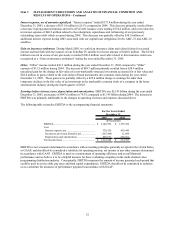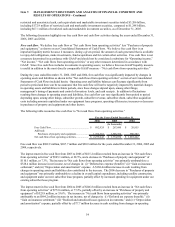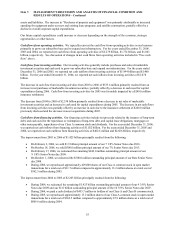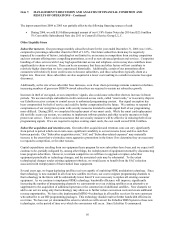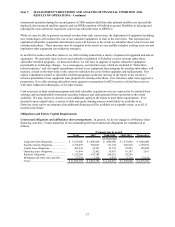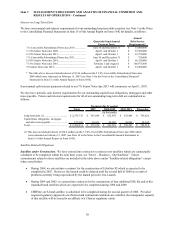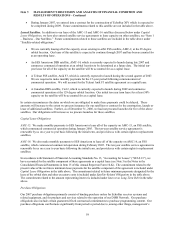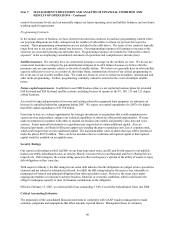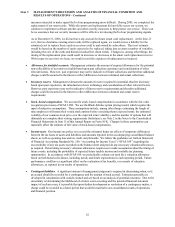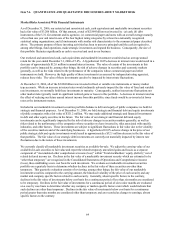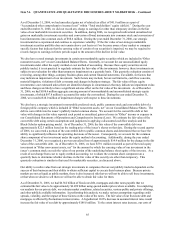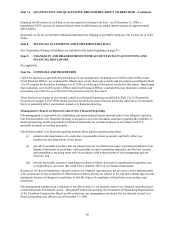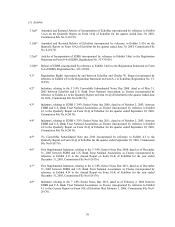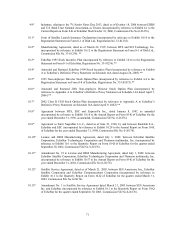Dish Network 2005 Annual Report Download - page 71
Download and view the complete annual report
Please find page 71 of the 2005 Dish Network annual report below. You can navigate through the pages in the report by either clicking on the pages listed below, or by using the keyword search tool below to find specific information within the annual report.Item 7. MANAGEMENT’S DISCUSSION AND ANALYSIS OF FINANCIAL CONDITION AND
RESULTS OF OPERATIONS – Continued
61
judgments and assumptions on historical experience and on various other factors that are believed to be reasonable
under the circumstances. Due to the inherent uncertainty involved in making estimates, actual results reported in future
periods may be affected by changes in those estimates. The following represent what we believe are the critical
accounting policies that may involve a high degree of estimation, judgment and complexity. For a summary of our
significant accounting policies, including those discussed below, see Note 2 in the Notes to the Consolidated Financial
Statements in Item 15 of this Annual Report on Form 10-K.
• Capitalized satellite receivers. Since we retain ownership of certain equipment provided pursuant to our new
and existing subscriber equipment lease programs, we capitalize and depreciate equipment costs that would
otherwise be expensed at the time of sale. Such capitalized costs are depreciated over the estimated useful life
of the equipment, which is based on, among other things, management’s judgment of the risk of technological
obsolescence. Because of the inherent difficulty of making this estimate, the estimated useful life of
capitalized equipment may change based on, among other things, historical experience and changes in
technology as well as our response to competitive conditions.
• Accounting for investments in private and publicly-traded securities. We hold debt and equity interests in
companies, some of which are publicly traded and have highly volatile prices. We record an investment
impairment charge when we believe an investment has experienced a decline in value that is judged to be
other than temporary. We monitor our investments for impairment by considering current factors including
economic environment, market conditions and the operational performance and other specific factors relating
to the business underlying the investment. Future adverse changes in these factors could result in losses or an
inability to recover the carrying value of the investments that may not be reflected in an investment’s current
carrying value, thereby possibly requiring an impairment charge in the future.
• Valuation of investments in non-marketable investment securities. We calculate the fair value of our
interest in non-marketable investment securities either at consideration given, or for non-cash acquisitions,
based on the results of valuation analyses utilizing a discounted cash flow or DCF model. The DCF
methodology involves the use of various estimates relating to future cash flow projections and discount
rates for which significant judgments are required.
• Valuation of long-lived assets. We evaluate the carrying value of long-lived assets to be held and used,
other than goodwill and intangible assets with indefinite lives, when events and circumstances warrant such
a review. We evaluate our satellite fleet for recoverability as one asset group, see Note 2 in the Notes to
the Consolidated Financial Statements in Item 15 of this Annual Report on Form 10-K. The carrying value
of a long-lived asset or asset group is considered impaired when the anticipated undiscounted cash flow
from such asset or asset group is less than its carrying value. In that event, a loss is recognized based on
the amount by which the carrying value exceeds the fair value of the long-lived asset or asset group. Fair
value is determined primarily using the estimated cash flows associated with the asset or asset group under
review, discounted at a rate commensurate with the risk involved. Losses on long-lived assets to be
disposed of by sale are determined in a similar manner, except that fair values are reduced for estimated
selling costs. Changes in estimates of future cash flows could result in a write-down of the asset in a future
period.
• Valuation of goodwill and intangible assets with indefinite lives. We evaluate the carrying value of
goodwill and intangible assets with indefinite lives annually, and also when events and circumstances
warrant. We use estimates of fair value to determine the amount of impairment, if any, of recorded
goodwill and intangible assets with indefinite lives. Fair value is determined primarily using the estimated
future cash flows, discounted at a rate commensurate with the risk involved. Changes in our estimates of
future cash flows could result in a write-down of goodwill and intangible assets with indefinite lives in a
future period, which could be material to our consolidated results of operations and financial position.
• Smart card replacement. We use microchips embedded in credit card-sized access cards, called “smart
cards,” or in security chips in our EchoStar receiver systems to control access to authorized programming
content. Our signal encryption has been compromised by theft of service and could be further
compromised in the future. We continue to respond to compromises of our encryption system with security



